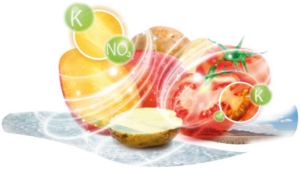The addition of potassium nitrate to the spray tank solution promotes the uptake and translocation of foliar-applied sulphated nutrients in plants, as well as nitrate-based and chelated forms . This was the main conclusion of research commissioned by the Potassium Nitrate Association (PNA) to Prof dr Ismail Cakmak (Sabanci University, Turkey) and presented by Harmen Tjalling Holwerda during the New Ag conference in Berlin on 16 March 2017.
The use of nitrate as opposed to sulphate in foliar nutrient sprays is generally accepted to be the most efficient in terms of both anion and cation uptake by the leaf and translocation within the plant. This is explained by the nitrate ion being smaller-sized than the sulphate ion, and the nitrate ion having a single negative charge, whereas the sulphate ion has a double negative charge. The research explored the benefit of nitrate when combined with cations such as zinc, magnesium, manganese or copper that are mainly spray applied as sulphated salts. Can nutrient uptake by the leaf and translocation within the plant be improved by adding a nitrate source to the spray tank solution which also contains sulphate ions from sulphated nutrient salts? (Figure 1).

Figure 1: Graphic presentation of the research question.
Three trials were designed to study the uptake and translocation of foliar-applied zinc (Zn) and magnesium (Mg) fertilisers in wheat and maize (Table 1). Table 2 shows the treatment overview with different forms of Zn- or Mg-salts applied singly or with the addition of KNO3.
Table 1. Trial overview. With the exception of trial 1B, all plants were grown in calcareous alkaline clay loam soil, with 0,05 ppm Zn added. Table 2. Foliar spray compositions : different forms of Zn- or Mg-salts, with or without KNO3. In Trial 3, Zn rate sprayed was 25% higher.
Table 2. Foliar spray compositions : different forms of Zn- or Mg-salts, with or without KNO3. In Trial 3, Zn rate sprayed was 25% higher. The Mg concentration in neither leaf nor grain was higher than the control after the single micronutrient applications, and consequently the absence of KNO3 effect may be due to the relatively low dose rate of Mg fertilisers (2% w/v) in the foliar spray. The effect of adding potassium nitrate at higher Mg- dose will be further investigated in a next series of trials.
The Mg concentration in neither leaf nor grain was higher than the control after the single micronutrient applications, and consequently the absence of KNO3 effect may be due to the relatively low dose rate of Mg fertilisers (2% w/v) in the foliar spray. The effect of adding potassium nitrate at higher Mg- dose will be further investigated in a next series of trials.In 2017, further trials are planned to study the effect of KNO3 on the uptake and translocation of foliar-applied Zn and Mg in wheat and soybean, and additionally the effect on iron-uptake is included.
Table 3. Main results of 2016 trials with Zn- or Mg-salts, with and without KNO3. A positive relative difference (%) in leaf or grain concentration of the micronutrients reflects the increase of this concentration when 2% KNO3 is added in the spray tank solution compared to application of only the micro-nutrient. * statistically significant at P=0,05.

The current results allow for the overall conclusion that Hnull (no positive effect of KNO3) has to be rejected and Halternative (a positive effect of KNO3) is accepted. The addition of potassium nitrate to the spray tank solution boosts the uptake and translocation in plants of foliar-applied sulphated nutrients, as well as nitrate-based and chelated forms . Science already supported the claim for potassium nitrate as the preferred source of N-NO3 and K in plant as well as its benefits to stimulate bud break and flowering induction. Now the data from this research, provide a novel, science-based reason to sell, promote and apply potassium nitrate.


